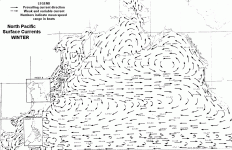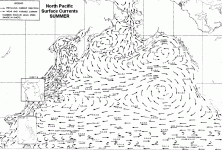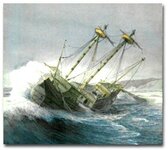whydahdiver
Full Member
- Apr 2, 2012
- 186
- 239
- Primary Interest:
- All Treasure Hunting
You might have already heard about the rusted-out, abandoned fishing vessel adrift off British Columbia, Canada. The 170 foot (53 meter) long vessel is the Ryou-Un Maru, a squid boat that broke free from a dock in Hokkaido, Japan, after the March 11, 2011 tsunami. Fortunately, no one was on board when the tsunami happened.
Over the past year it has drifted across the Pacific Ocean and was first observed in Canadian waters. The U.S. Coast Guard is now tracking the drift of the vessel, which entered U.S. waters March 31, 2012, and currently it is about 155 nautical miles away from Baranof Island in southeast Alaska.
The drift of the vessel confirms what generations of beach combers have known for a long time. The Pacific Ocean currents form a giant conveyor belt that carries flotsam (floating items) across the Pacific. Over the years I’ve found glass fish floats, glass bottles, and other Japanese items that have washed up along the coast of Washington state where I live.
But a big fishing vessel—that must be something really unusual—or is it?
In 2003, the 97-foot ship Genei Maru #7 [leaves this blog] caught fire and was abandoned at sea about halfway between Japan and the United States. This “ghost ship” ran aground on Kodiak, Alaska, after drifting at sea, crewless, for five months. And in 2006, the U.S. Coast Guard found an abandoned coal barge adrift off the Kenai Peninsula of Alaska, which had wandered across the Pacific from Russia.
The document, "Record of Japanese Vessels Driven Upon the North-West Coast of America and its Outlying Islands," was originally published in 1872.
But there is evidence that vessels have been drifting across the Pacific for a long time. Check out this old document from 1872, “Record of Japanese Vessels Driven Upon the North-West Coast of America and its Outlying Islands.”
Some archaeologists think that Indigenous cultures of the Pacific Northwest Coast have been strongly influenced by the effects of foreign shipwrecks.
Artifacts from shipwrecks, including metals and other technologies, may have been used by these tribes (Quimby, G. I. 1985. Japanese Wrecks, Iron Tools, and Prehistoric Indians of the Northwest Coast. Arctic Anthropology 22(2): 7–15.).
And the blog A Blast From the Past [leaves this blog] has a lengthy discussion on historical and more recent cases of vessels washing across the Pacific. The oldest record is from 1617, when an abandoned Japanese ship was found near Acapulco, Mexico, but there are likely many other wrecks that went unrecorded because the vessels probably stranded in areas then inhabited only by native tribes.
The March 2011 tsunami certainly added to the amount of debris floating across the Pacific. If you find items you think might be from the tsunami, you can report them to [email protected].
Over the past year it has drifted across the Pacific Ocean and was first observed in Canadian waters. The U.S. Coast Guard is now tracking the drift of the vessel, which entered U.S. waters March 31, 2012, and currently it is about 155 nautical miles away from Baranof Island in southeast Alaska.
The drift of the vessel confirms what generations of beach combers have known for a long time. The Pacific Ocean currents form a giant conveyor belt that carries flotsam (floating items) across the Pacific. Over the years I’ve found glass fish floats, glass bottles, and other Japanese items that have washed up along the coast of Washington state where I live.
But a big fishing vessel—that must be something really unusual—or is it?
In 2003, the 97-foot ship Genei Maru #7 [leaves this blog] caught fire and was abandoned at sea about halfway between Japan and the United States. This “ghost ship” ran aground on Kodiak, Alaska, after drifting at sea, crewless, for five months. And in 2006, the U.S. Coast Guard found an abandoned coal barge adrift off the Kenai Peninsula of Alaska, which had wandered across the Pacific from Russia.
The document, "Record of Japanese Vessels Driven Upon the North-West Coast of America and its Outlying Islands," was originally published in 1872.
But there is evidence that vessels have been drifting across the Pacific for a long time. Check out this old document from 1872, “Record of Japanese Vessels Driven Upon the North-West Coast of America and its Outlying Islands.”
Some archaeologists think that Indigenous cultures of the Pacific Northwest Coast have been strongly influenced by the effects of foreign shipwrecks.
Artifacts from shipwrecks, including metals and other technologies, may have been used by these tribes (Quimby, G. I. 1985. Japanese Wrecks, Iron Tools, and Prehistoric Indians of the Northwest Coast. Arctic Anthropology 22(2): 7–15.).
And the blog A Blast From the Past [leaves this blog] has a lengthy discussion on historical and more recent cases of vessels washing across the Pacific. The oldest record is from 1617, when an abandoned Japanese ship was found near Acapulco, Mexico, but there are likely many other wrecks that went unrecorded because the vessels probably stranded in areas then inhabited only by native tribes.
The March 2011 tsunami certainly added to the amount of debris floating across the Pacific. If you find items you think might be from the tsunami, you can report them to [email protected].






